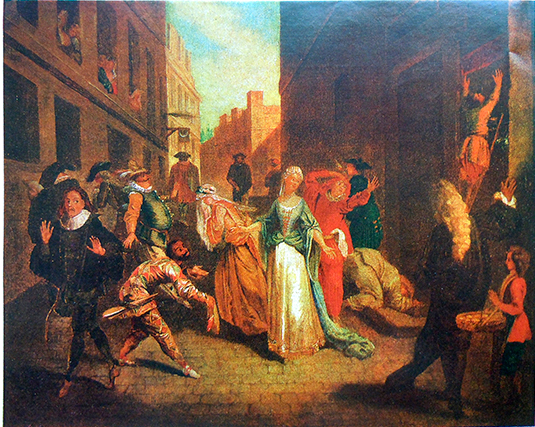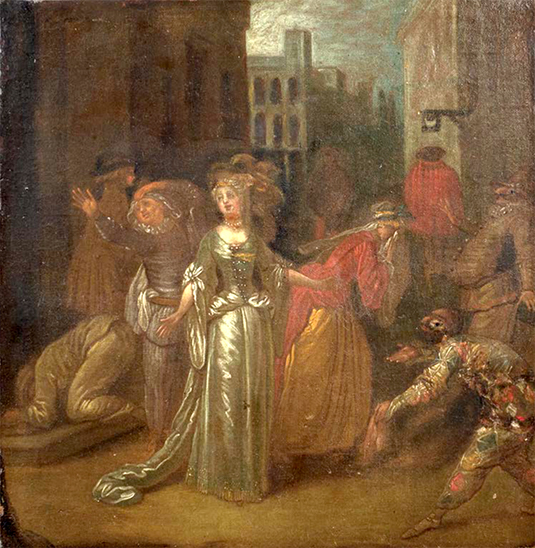
- Home Page
- Accepted
Paintings & Copies - Doubtful
Attributions - Doubtful Textual References
- Alternative
Titles - Collectors &
Museums - Bibliography
- Search Abecedario
- Watteau &
His Circle
Le Départ des comédiens italiens (copy 1)
Entered May 2020

Whereabouts unknown
Oil on canvas
33 x 42 cm
PROVENANCE
Versailles, sale, June 3, 1970, lot 231: “JEAN-ANTOINE WATTEAU (ATTRIBUE A) . . . LE DEPART DES COMEDIENS ITALIENS. La scène se passe en 1697. C’est l’époque de Louis XIV viellissant et déjà malade, tourmenté par les revers de ses armes et par la famine qui sévit dans les campagnes, pense au sauvetage de son âme qu’il a confiée à la pieuse Mme de Maintenon, secrètement épousée. Un libelle, imprimé a La Haye, court, hostile à Mme de Maintenon. Les Comédiens Italiens l’auraient inspiré. Mme de Maintenon obtient du monarque que la troupe soit chassée de l’Hôtel de Bougogne où elle donne ses représentations.
La dispersion a lieu dans la rue, sous le regard des voisins penchés dans leur croisées. La gracieuse Colombine, dans ses beaux autours, occupe le centre de la composition. A sa droite, Zerbinette se lamente. A sa gauche, Arlequin lève les bras au ciel. Scapin, la batte au côté, la salue encore, et le Docteur regarde le garçon qui, monté sur une échelle, enlève l’annonce de la dernière représentation. Autour, de nombreux acteurs qui expriment la surprise ou la douleur.
Toile. Hauteur: 33 cm. Largeur: 42 cm.
Gravé par L. Jacob (dans le même sens) en 1729 et reproduit dans l’ouvrage de DACIER, «L’oeuvre gravé de WATTEAU» sous le no 184.
—La gravure mentionne des dimensions différentes, soit: hauteur 51,3 cm, largeur 62,1 cm. Mais la vérification de ces mesures est rendue impossible puisque la toile ayant fait partie de la Collection de l’Abbé PENETTI, secrétaire du chargé d’affaires de Florence et ami de Mariette, dispersée le 5 mars 1837 sous le no 69, puis de la Collection BETTE, dispersée le 9 janvier 1839 sous le no 118, a disparu depuis (ainsi que le signale l’ouvrage de René HUYGHE et Hélène ADHEMAR sous le no 8, page 202).
—Selon nous, il pourrait s’agir, soit du tableau ci-dessus dont les dimensions signalées sur la gravure seraient fausses (comes il arrive parfois), soit d’une seconde, version réduite qui aurait été executée par WATTEAU d’après un dessin de GILLOT, entre 1704 et 1708, alors qu’une grande intimité liait les deux artistes, Car, au moment du départ des Comédiens Italiens en 1697, WATTEAU n’avait pas encore gagné Paris.” Sold for 40,000 francs.
SELECT BIBLIOGRAPHY
Plax, Watteau and Cultural Politics (2000), 193 n.1.
Ravel, “Trois images de l’expulsion” (2013).
Plax, The Departure of the Commedia dell'Arte" (2018), 60.
REMARKS
There can be no question that this is a copy of Watteau’s composition, based on Jacob’s engraving. The poor execution of the boy at the right reveals the copyist’s shortcomings. While ultimately faithful to the engraving, there are telling mistakes in details such as the omission of Scaramouche’s moustache, the missing fontanges on the women looking out the windows, and the blurred sign being posted on the wall of the Hôtel de Bourgogne.
Le Départ des comédiens italiens en 1697 (copy 2)
Entered May 2020

Whereabouts unknown
Materials unknown
Measurements unknown
ALTERNATIVE TITLES
Les Acteurs italiens chassés de l’hôtel de Bourgogne par ordonnance de Louis XIV
PROVENANCE
Paris, sale, Hôtel des ventes mobilières, May 5-6, 1837, lot 69: “VATTEAU . . . Les Acteurs Italiens chassés de l’hôtel de Bourgogne par ordonnance de Louis XIV: riche composition, brilliante de ton, et d’une grande liberté de pinceau.”
Paris, collection of Jean-Baptiste Berré (1777-1839; painter). His sale, Paris, January 9-10, 1839, cat. 116: WATTEAU. Les acteurs italiens chassés de l’hôtel de Bourgogne par ordonnance de Louis XIV; tableau capital d’une riche composition.” Sold for 127 francs.
SELECT BIBLIOGRAPHY
Adhémar, Watteau (1950),under cat. 8.
Macchia and Montagni, L’opera completa di Watteau (1968), under cat. 8.
Plax, The Departure of the Commedia dell'Arte" (2018), 60.
REMARKS
Although Adhémar cites the paintings in the 1837 and 1839 sales as if they were the original Watteau picture, there is no reason to assume this. The closeness of the dates of sale and the similarity of phrasing in the two sale descriptions make it likely that they refer to the same painting.
The later whereabouts of the picture are unclear. It might have been taken immediately to London and sold there a few months later (our copy 3). Or, if it stayed in Paris, it might be the one sold there in 1868 (our copy 4) or the one sold in Paris in 1842 under Lancret’s name (our copy 5).
Le Départ des comédiens italiens en 1697 (copy 3)
Entered May 2020

Whereabouts unknown
Medium unknown
Measurements unknown
ALTERNATIVE TITLES
The Italian Actors Driven from the Hotel Bourgogne by Order of Louis XIV
PROVENANCE
London, sale, Foster and Sons, March 6, 1839, lot 78: “WATTEAU . . . The Italian Actors driven from the Hotel Bourgoyne by order of Louis XIV. This historical and curious picture is engraved, the portrait of Moliere is introduced.”
REMARKS
The description of the painting follows that used for the copy sold in Paris in 1837 and January 1839 (our copy 2). The March 1839 sale was advertised as containing ”Pictures Just Imported from the Continent,” so it is conceivable that the picture was the one just on the Paris market several months earlier.
Le Départ des comédiens italiens en 1697 (copy 4)
Entered May 2020

Whereabouts unknown
Medium unknown
Measurements unknown
PROVENANCE
Paris, collection of Monsieur O. His sale, Paris, April 11, 1868, cat. 83: “WATTEAU . . . Départ des comédiens italiens.”
REMARKS
This picture may have been the same one sold in Paris under Watteau’s name in 1837 and 1839 (our copy 2).
Le Départ des comédiens italiens en 1697 (copy 5)
Entered May 2020

Whereabouts unknown
Medium unknown
Measurements unknown
ALTERNATIVE TITLES
Les Comédiens de l’Hôtel de Bourgogne chassés de leur théâtre.
PROVENANCE
Paris, collection of Monsieur G (magistrate). His sale, Paris, Hôtel des commissaires-priseurs, May 25, 1842, lot 2: “LANCRET. Les Comédiens de l’hôtel de Bourgogne chassés de leur théâtre.”
SELECT BIBLIOGRAPHY
Wildenstein, Lancret (1924), cat. 268.
Adhémar, Watteau (1950), under cat. 8.
REMARKS
Despite the ascription to Lancret, who rarely treated such historical subjects, much less this specific one, it seems likely that this painting emulated Watteau’s version. It may actually be the copy sold in Paris under Watteau’s name just a few years earlier—in 1837 and 1839 (our copy 2). Adhémar cited all three examples but did not consider them as one work.
Le Départ de comédiens italiens (copy 6)
Entered May 2020

Columbia, Missouri, Museum of Art and Archaeology, University of Missouri, inv. 75.196
Oil on canvas
36 x 35 cm
ALTERNATIVE TITLES
The Departure of the Commedia dell’arte from Paris in 1697
PROVENANCE
Collection of Mrs. Irene Taylor; donated to the museum in 1975.
SELECT BIBLIOGRAPHY
Plax, Watteau and Cultural Politics (2000), 10, 192 n.1 and passim.
Ravel, “Trois images de l’expulsion des Comédiens Italiens” (2013).
Plax, The Departure of the Commedia dell'Arte" (2018), 52-57, 60.
REMARKS
This painting, of greatly inferior quality, has compressed most of Watteau’s figures into a very tight space, changing the horizontal composition into one that is essentially square. Prior to cleaning, the picture supposedly bore the signature of François Joseph de la Pierre, a painter received into the Paris Academy of St. Luc in 1741.
Le Départ de comédiens italiens (copy 7)
Entered May 2020

Whereabouts unknown
Medium unknown
Measurements unknown
PROVENANCE
Paris, sale, Hôtel des commissaires-priseurs, June 16-17, 1835, lot 79: “GILLOT. Molière et ses acteurs déménageant de l’hôtel de Bourgogne.”
SELECT BIBLIOGRAPHY
Populus, Gillot (1930), 25.
REMARKS
Populus cleverly associated the sale of this painting with Watteau’s Le Départ des comédiens italiens en 1697. There is no record that Gillot ever painted such a subject but, as has been pointed out, a theory soon developed that Gillot had designed Watteau’s painting.
It could well be that this painting was one of the several copies sold in Paris in the 1830s. It should be noted that when our copy 3 sold in 1839, it was claimed that one of the figures in the painting was Molière.
Click here for Le Départ de comédiens italiens